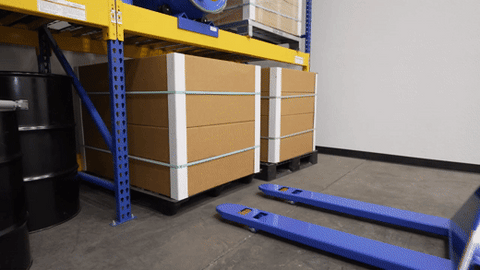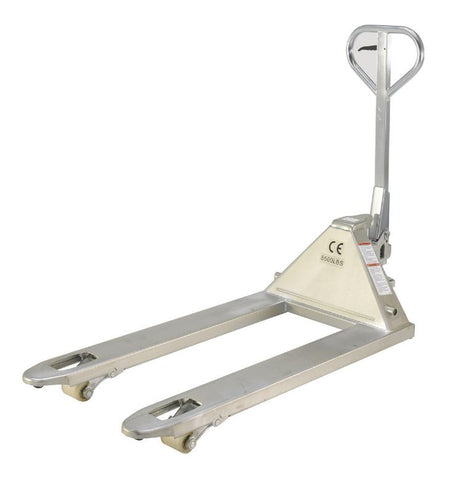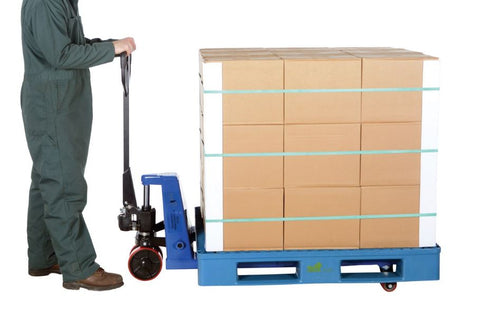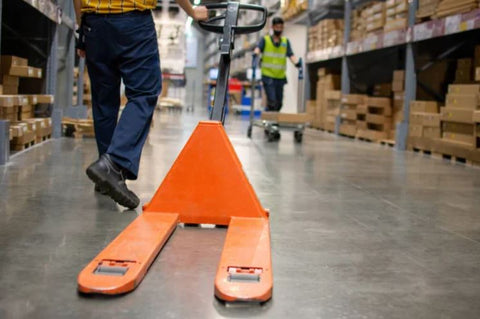Your Guide to Pallet Trucks
Pallet trucks are essential tools in warehouses, distribution centers, and other material handling settings. They provide a cost-effective and efficient solution for moving heavy loads and pallets. Whether you are new to a pallet truck or looking to upgrade your existing equipment, this ultimate guide will provide you with all the information you need to make an informed decision.

Understanding Pallet Trucks
In order to fully grasp the benefits and functionalities of pallet trucks, it is important to start with the basics. Pallet trucks, also known as pallet jacks or pump trucks, are manual or electric-powered devices used to lift and transport pallets. They are designed to be operated by a single operator and are widely used in various industries for loading and unloading goods.
The Basics of Pallet Trucks
At its core, a pallet truck consists of a set of forks or blades that slide under a pallet. By pumping the handle up and down, the operator can raise the forks, lifting the load off the ground. The load is then transported by maneuvering the truck using the steering handle. Pallet trucks typically have a load capacity ranging from 1,500 to 6,000 pounds, depending on the model. They are capable of maneuvering in tight spaces and can operate in both indoor and outdoor environments.
Types of Pallet Trucks
There are several types of pallet trucks available, each designed to meet specific requirements. The most common types include manual pallet trucks, electric pallet trucks, and specialized pallet trucks.
Manual pallet trucks are operated by pumping the handle manually to lift the forks. They are easy to maneuver and require minimal maintenance. Electric pallet trucks, on the other hand, are powered by electric motors, making them suitable for larger loads and longer distances.
Specialized pallet trucks cater to specific needs, such as rough terrain, cold storage, or narrow aisles. These trucks are equipped with features that enable them to operate efficiently in challenging environments.

Key Components of a Pallet Truck
A pallet truck consists of several key components that work together to ensure smooth operation and maximum efficiency. These components include the forks, wheels, hydraulic system, and steering handle.
The forks are the main lifting mechanism and are designed to fit under the pallet. They are constructed of durable materials to withstand heavy loads. The wheels, typically made of polyurethane or nylon, provide stability and ease of maneuverability.
The hydraulic system is responsible for lifting and lowering the forks. It utilizes hydraulic pressure to raise the load off the ground and maintain a consistent height while in transport. The steering handle allows the operator to navigate the pallet truck efficiently, ensuring precise control. Another important component of a pallet truck is the load backrest. This is a protective feature located at the back of the forks, preventing the load from shifting or falling backward during transport. It enhances safety and stability, ensuring that the goods remain secure on the pallet.
Furthermore, some pallet trucks are equipped with additional features such as adjustable forks, which allow for easy adaptation to different pallet sizes. Others may have built-in scales, enabling operators to weigh the load directly on the truck, eliminating the need for separate weighing equipment. Overall, pallet trucks are versatile and essential tools in the material handling industry. They streamline the process of moving heavy loads, increasing productivity and reducing the risk of injuries associated with manual lifting. Whether it's a small warehouse or a large distribution center, pallet trucks play a crucial role in ensuring efficient and safe operations.
Choosing the Right Pallet Truck for Your Needs
When it comes to selecting the right pallet truck for your specific needs, there are several factors to consider. Assessing your operational requirements, considering the load capacity, and factoring in the terrain and environment are all crucial considerations.
Assessing Your Operational Requirements
Before making a decision, evaluate your daily operations and determine the frequency and intensity of pallet truck usage. Consider factors such as the types of loads, distances travelled, and overall workload. This analysis will help you identify the type of power source, load capacity, and other features required.
For example, if your operations involve frequent and heavy lifting, you may want to consider a powered pallet truck with a higher load capacity. This will help reduce the strain on your workers and increase productivity. On the other hand, if your operations involve lighter loads and shorter distances, a manual pallet truck may be sufficient and more cost-effective.

Considering the Load Capacity
The load capacity of a pallet truck is one of the most important factors to consider. It is essential to choose a truck that can safely handle the weights of your typical loads. Overloading a pallet truck can lead to accidents and equipment damage. Be sure to account for the weight of the load itself, as well as any additional attachments or accessories. When determining the load capacity, it is also important to consider any future growth or changes in your operations. If you anticipate an increase in load sizes or weights, it is wise to choose a pallet truck with a higher load capacity to accommodate these changes without the need for immediate replacement.
Factoring in the Terrain and Environment
Another crucial aspect to consider is the terrain and environment in which the pallet truck will be used. If you operate in a large warehouse or outdoor setting, an electric pallet truck may be the best choice for increased efficiency and reduced operator fatigue.
Electric pallet trucks are designed to handle longer distances and heavier loads with ease, making them ideal for large warehouses or distribution centers. They also offer features such as regenerative braking and ergonomic controls, further enhancing operator comfort and safety.
Alternatively, specialized pallet trucks may be necessary for rough terrain or cold storage areas. For example, rough terrain pallet trucks are equipped with larger wheels and a more robust frame to navigate uneven surfaces and outdoor environments. Cold storage pallet trucks, on the other hand, are designed to withstand low temperatures and have features such as insulated cabins and heated controls.
By carefully assessing your operational requirements, considering the load capacity, and factoring in the terrain and environment, you can choose the right pallet truck that will optimize your productivity, ensure safety, and meet your specific needs.
Operating a Pallet Truck Safely
Ensuring the safe operation of pallet trucks is vital to prevent accidents and injuries in the workplace. By following basic operating instructions, adhering to safety precautions and tips, and conducting regular maintenance checks, you can create a safe working environment for your operators.
Basic Operating Instructions
Before operating a pallet truck, it is important to understand its functionalities and controls. Familiarize yourself with the lifting and lowering mechanisms, steering handle, and braking system. Ensure that all operators receive proper training and are aware of the correct techniques for loading and unloading pallets.
When operating the pallet truck, it is crucial to maintain a proper body posture. Keep your back straight and use your legs to push or pull the truck, avoiding any unnecessary strain on your back. Additionally, always maintain a firm grip on the steering handle and use smooth, controlled movements to prevent sudden jolts or jerks.

Safety Precautions and Tips
Implementing safety precautions is essential for preventing accidents. Always inspect the pallet truck before each use for any signs of damage or malfunction. Check the tires for proper inflation and ensure that the brakes are in good working condition. It is also important to regularly check the visibility of the operator's area, making sure that mirrors and lights are clean and functional.
When it comes to loading and unloading pallets, make sure to follow the recommended weight distribution guidelines. Placing heavier items at the bottom and lighter items on top will help maintain stability during transportation. Additionally, be cautious of any loose or protruding items on the pallet that may pose a hazard during operation.
Maintenance and Regular Checks
Maintaining your pallet truck is crucial for its longevity and safe operation. Follow the manufacturer's guidelines for regular maintenance checks, such as inspecting the forks, wheels, and hydraulic system for any signs of wear or damage. Lubricate moving parts as recommended, and promptly address any issues or malfunctions.
Regularly cleaning the pallet truck is also important to prevent the accumulation of debris and dirt that can affect its performance. Use a mild detergent and water to clean the truck, paying special attention to the wheels and forks. Additionally, check the battery if your pallet truck is electric-powered, ensuring that it is properly charged and functioning optimally.
By incorporating these additional safety measures and maintenance practices, you can further enhance the safe operation of your pallet truck, reducing the risk of accidents and promoting a secure working environment for your operators.
Advanced Pallet Truck Features
As technology advances, so do the features and capabilities of pallet trucks. Understanding these advancements and the benefits they offer can help you make an informed decision when choosing your pallet truck.
Technological Advancements in Pallet Trucks
Many modern pallet trucks are equipped with advanced technological features, such as built-in scales, ergonomic designs, and customizable controls. These features enhance efficiency, accuracy, and operator comfort. Consider the specific needs of your operation to determine if these advanced features are necessary.
Benefits of Electric Pallet Trucks
Electric pallet trucks offer numerous advantages over their manual counterparts. They are easier to maneuver, require less physical effort from the operator, and often have higher load capacities. Additionally, electric pallet trucks can be equipped with lithium-ion batteries for extended run times and quick charging capabilities.

Understanding Specialized Pallet Trucks
Specialized pallet trucks are designed for specific applications, such as rough terrain, low-temperature environments, or narrow aisles. These trucks are equipped with features that enable them to operate efficiently in these specialized settings. Assess your operational requirements to determine if a specialized pallet truck is the right choice for your needs.
Now that you have a comprehensive understanding of pallet trucks and their various aspects, you can confidently choose the right pallet truck for your needs. By following proper operating procedures and maintenance practices, you can ensure the safe and efficient operation of your pallet truck, ultimately increasing productivity and reducing risks in your workplace.

